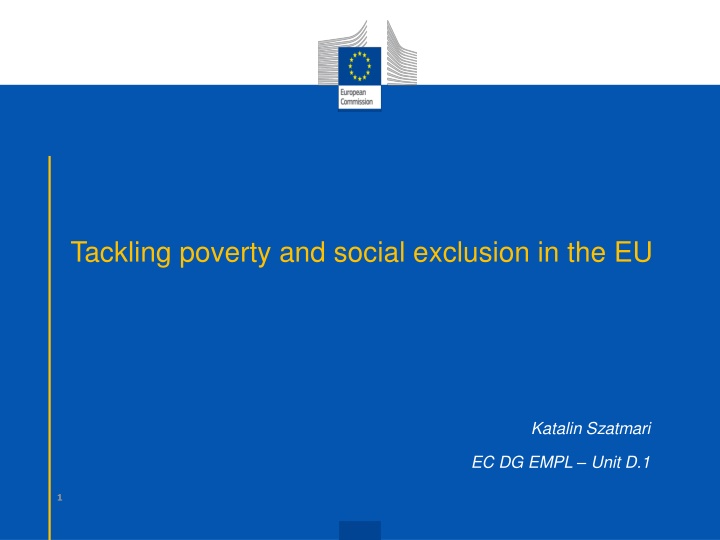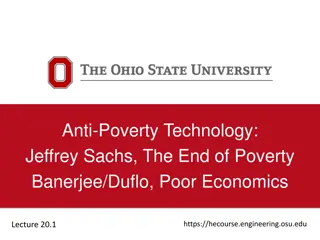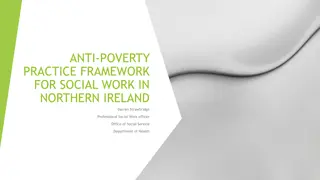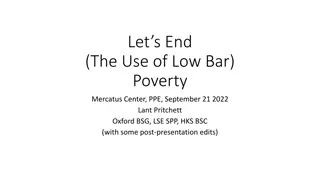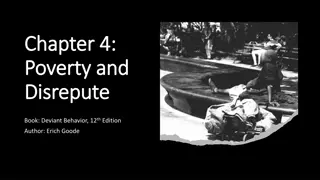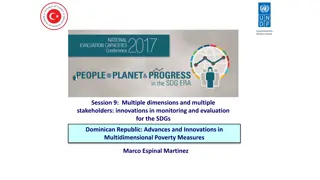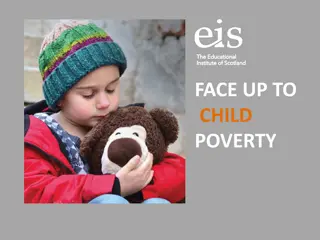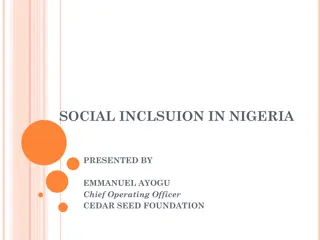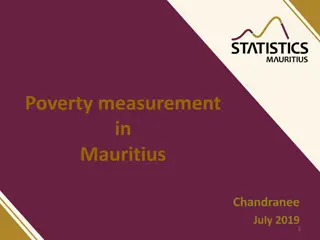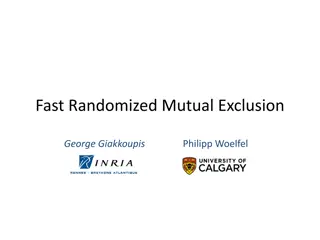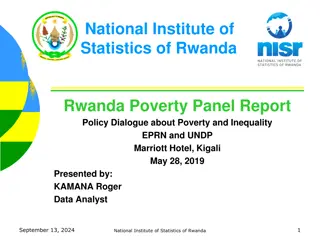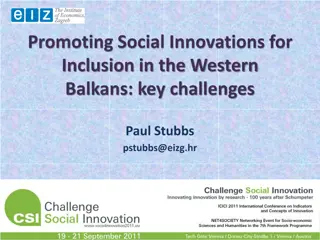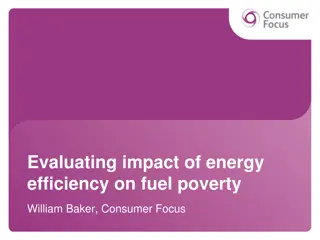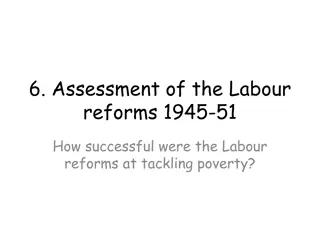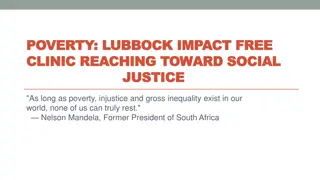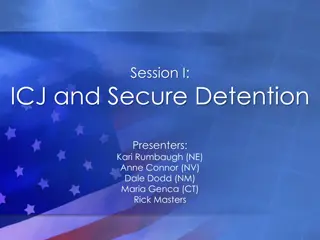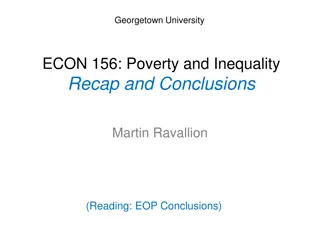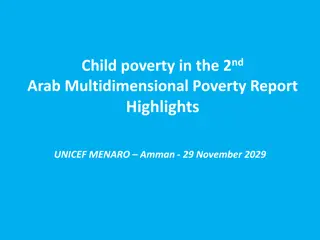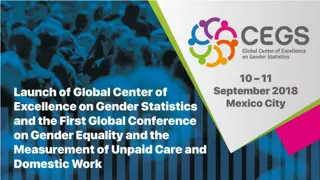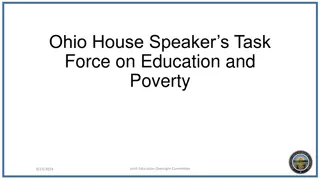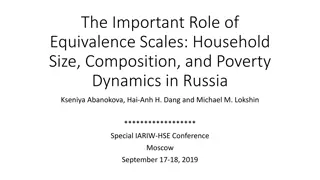Tackling Poverty and Social Exclusion in the EU
Addressing poverty and social exclusion in the European Union through policy frameworks, key indicators, social innovation, and the European Pillar of Social Rights. Includes insights on AROPE and additional poverty indicators.
Download Presentation

Please find below an Image/Link to download the presentation.
The content on the website is provided AS IS for your information and personal use only. It may not be sold, licensed, or shared on other websites without obtaining consent from the author.If you encounter any issues during the download, it is possible that the publisher has removed the file from their server.
You are allowed to download the files provided on this website for personal or commercial use, subject to the condition that they are used lawfully. All files are the property of their respective owners.
The content on the website is provided AS IS for your information and personal use only. It may not be sold, licensed, or shared on other websites without obtaining consent from the author.
E N D
Presentation Transcript
Tackling poverty and social exclusion in the EU Katalin Szatmari EC DG EMPL Unit D.1 1
Overview 1. Overall policy framework 2. Key indicators for measuring poverty and main challenges 3. Policy responses 4. Role of social innovation 5. Resources
Title X of TFEU on SOCIAL POLICY (e.g. combating social exclusion, social protection) Member State to act as first competence National, local, regional authorities The EU shall support and complement Guidance, Monitoring, Mutual Learning, Exchange of good practices, Financial support Chapter III Social Protection and Social Inclusion European Pillar of Social Rights (EPSR) To reduce the number of people at risk of poverty and social exclusion by at least 15 million by 2030, of which 5 million children EPSR Action Plan and Porto Declaration Principles into actions (e.g. European Child Guarantee, Minimum Income Recommendation, Report on access to essential services, Homelessness Platform, Disability Strategy, etc.)
The European Pillar of Social Rights Income support 1.Principle 14, also 15 (pensions) 2.14. - The right to adequate minimum income 3.benefits ensuring a life in dignity and 4.enabling goods and services, combined 5.with incentives to (re)integrate 6.into the labour market Inclusive Labour Markets 1.Principle 4, 12, 13 2.The right to timely and tailor-made assistance to improve employment or self- employment prospects; the right to adequate activation support from PES to re/integrate in the labour market, and adequate unemployment benefits. Access to quality services 1.Principle 14 - the right to effective access to enabling services. 2.Other principles: childcare and support to children(11), essential services (20), wages in-work poverty (6), healthcare (16), people with disabilities (17), education, training (01), LTC (18), housing (19)
At-risk-of poverty and social exclusion (AROPE) AROP Definition Persons who are either at risk of poverty (AROP), or severely materially and socially deprived (SMSD)or living in a household with a very low work intensity (VLWI). [Or in two or all situations] VLWI (quasi- jobless) SMSD Glossary:At risk of poverty or social exclusion (AROPE) - Statistics Explained (europa.eu) It is a composite indicator to reflect multidimensionality of poverty - Monetary poverty: at-risk of poverty < 60% median income (relative) - Living conditions: severe material and social deprivation - Work dimension: living in quasi-jobless households
Additional indicators Relative median at-risk-of-poverty gap (measures depth of poverty): difference between the median equivalised disposable income of people below AROP threshold and the AROP threshold, expressed as % of AROP threshold. Persistent at-risk-of-poverty rate: % people below the AROP threshold in the current year and in at least 2 of the 3 preceding years In-work at-risk-of-poverty rate: % of employed individuals (18-64y) being AROP mainly to be addressed by labour market policies (e.g. minimum wages, but access to services and social protection are also important) Material and social deprivation rate: % of persons with an enforced lack at least 5 items in a basket of 13 material and social deprivation items. Impact of social transfers (excl. pensions) on poverty reduction: Reduction in percentage of AROP rate due to in-cash social transfers (excl. pensions): calculated by comparing AROP rate before in-cash social transfers with AROP rate after in-cash social transfers (where transfers excl pensions). [Social scoreboard headline indicator ] Expenditure on social protection: includes social benefits, both in cash and in kind, administration costs and other expenditure related to social protection schemes. It is expressed in current price as a percentage of the GDP, also provided per head of population, by type (e.g. social benefit, administration cost) or by function (e.g. social protection, health, education). Disaggregation (i.e. breakdowns) is important: By: age, (sex), household type, activity status, education, urban/rural, disability, etc
Poverty and social exclusion by EPSR scoreboard Social Scoreboard headline indicators: At-risk-of poverty or social exclusion rate (and AROPE components) Impact of social transfers (excl. pensions) on poverty reduction At-risk-of poverty or exclusion rate for children (and AROPE components) Children aged less than 3 years in formal childcare Early leavers from education and training In addition: Break-down by vulnerable groups e.g. At risk of poverty and social exclusion rate for PwDs stands at 29,7% at the EU level, reaching up to 45% in some national contexts, compared to 18,8% for persons without disabilities Indicators to monitor the policy responses (Benchmarking frameworks) 7
Poverty challenges Source: Statistics | Eurostat (europa.eu) Note: for AROPE: data from SILC 2010 to SILC 2014 is based on old definition of AROPE. Data from SILC 2015 to SILC 2021 is based on new definition of AROPE. There s a break in EU27 data in SILC 2020 for both (new) AROPE and poverty gap (mainly due to change in methodology for DE data).
The overall main challenges - Situation in the EU Employment and social situation improving before Covid 19, yet: remaining high poverty and social exclusion at EU level despite economic and employment growth significant differences among the Member States The negative impact of Covid-19 on poverty and social exclusion was effectively mitigated, yet: Gaps in social protection remain and were addressed only as temporary/emergency measures Certain groups were more affected Data 2020 and 2021, and early estimates, indicate overall stability for poverty and social exclusion across Member States, BUT: The current climate of economic and geopolitical uncertainty threatens post- pandemic recovery, including social conditions Inflationary pressure and energy price peaks could have consequences on poverty and social inclusion Careful monitoring, while social protection systems may remain under pressure
Initiative package to tackle various challenges of poverty and social exclusion The Directive on adequate minimum wages seeks to establish a framework to improve the adequacy of minimum wages and to increase the access for workers to minimum wage protection, thereby contributing to addressing in-work poverty and low-wage traps. The Council Recommendation on the integration of the long-term unemployed into the labour market recommends that Member States provide individual support to long-term unemployed and encourage a better coordination of relevant services. The Council Recommendation on access to social protection for workers and the self-employed aims at ensuring that all of them contribute and have formal access to effective, adequate and transparent social protection systems. European Child Guarantee invites Member States to guarantee for children at risk of poverty or social exclusion free and effective access to key services. The social economy action plan helps social economy thrive, tapping into its economic and job-creation potential. (forthcoming council recommendation) The European Care Strategy to ensure quality, affordable and accessible care services and improve the situation for both care receivers and the people caring for them. The European Platform on Combatting Homelessness to trigger dialogue, facilitate mutual learning, improve evidence and monitoring, and strengthen cooperation among all actors. The Council recommendation on adequate minimum income, ensuring active inclusion is the most recent initiative to provide guidance for reforms in social inclusion and social assistance
Social protection and inclusion Social protection systems are key for tackling poverty respond to social risks, such as job loss, weak health conditions, or old age contribute to prevent and alleviate poverty, including during shocks responding to systemic risks contributory based vs means tested income support variety of social protection and inclusion systems across the Member States specific challenges regarding coverage and adequate income and service support Active Inclusion approach - integrated policy mix of income support, activation and social services Income support 1.Individual s basic right to resources and social assistance sufficient to lead a life in dignity Inclusive Labour Markets 1.People fit for work receive effective help to enter or re-enter employment Access to quality services 1.Enabling services (housing support, childcare, long-term care, health services)
Key elements of EU framework on active inclusion Council Recommendation 92/441/EEC on common criteria concerning sufficient resources and social assistance in social protection systems, called on Member States: recognising the basic right of a person to sufficient resources and social assistance to live in a manner compatible with human dignity; fixing amounts of resources sufficient to cover essential needs, taking into account living standards and price levels; periodical review; safeguarding incentives to work; receive activation and social support. The Commission Recommendation 2008/867/EC on the active inclusion of people excluded from the labour market: sets out a comprehensive strategy to facilitate the integration into employment of those who can work and to provide resources to live in dignity, together with support for social participation, for those who cannot; combines three policy strands: adequate income support, inclusive labour markets and access to quality services.
Objective and scope of the new Recommendation on adequate minimum income - (2023/C 41/01) Legal basis: Article 153(1)(j) combating social exclusion , recognition of Member States competences in the area of social protection With a view to ensure a life in dignity at all stages of life, the Recommendation aims at combatting poverty and social exclusion by promoting: adequate income support, effective access to enabling and essential services fostering labour market integration of those who can work In line with the active inclusion approach Scope: persons lacking sufficient resources i.e. those with insufficient, irregular, or uncertain monetary and material resources, which are indispensable for their health and well-being and for participating in the economic and social life.
Challenges and building blocks Adequacy (Non)-take up Coverage Governance monitoring and reporting Access to enabling and essential services Access to inclusive labour market Individualized support
EU funding ESIF, in particular European Social Fund Plus (ESF+), including FEAD and EaSI Recovery and Resilience Plans Technical Support Instrument (TSI) 216 measures for around EUR 13.4 billion linked to social protection and inclusion EUR 99.3 billion for 2021- 2027 35 ongoing projects, with a dedicated total budget of EUR 16 million. earmarking of 25% for social inclusion and 3% for material deprivation Tailor-made technical expertise to the Member States to design and implement reforms in the area of social benefits and services. reforms in Member States, where challenges were identified by the country specific recommendations - Latvia, Lithuania, Croatia, Spain, Romania and Bulgaria. supporting reforms and investments to modernize social and access to essential services The support is demand driven and does not require co-financing from Member States. Additional EUR 13.8 billion of ERDF to improving access to quality social services.
EaSI calls for social innovation New models) that simultaneously meet social needs and create new social relationships or collaborations. These are social in both their ends and their means and Enhance society scapacity to act. ideas (products, services and
Social Innovation Calls for Proposals Unit EMPL.D1 Amount available in No. of received proposals No. of projects selected Total Year Call No. Targeted policy field Commitment in VP/2012/007 Social Policy Experimentations 4.200.000,00 128 5 4.018.318,51 2012 PROGRESS Social Policy Experimentations supporting Social Investments VP/2013/012 3.500.000,00 67 4 3.263.815,76 2013 PROGRESS Social Policy Innovations supporting reforms in Social Services stemming from the Recommendation (2008) and the Social Investment Package (2013) EaSI PROGRESS Axis VP/2014/008 Active Inclusion 11.040.000,00 113 7 10.489.387,93 2014 Social policy innovations supporting reforms in social services follow-up of the previous call EaSI PROGRESS Axis VP/2015/011 10.800.000,00 132 8 10.528.298,70 2015
Social Innovation Calls for Proposals Unit EMPL.D1 (contd) Amount available in No. of received proposals No. of projects selected Total Year Call No. Targeted policy field Commitment in Social innovation: Fast track integration into the labour market for third country nationals targeting exclusively asylum seekers, refugees and their family members reflecting to the migration crisis Social innovation and national reforms Innovative Work-life balance strategies - linked to the Work-Life Balance legislative initiative as part of the European Pillar of Social Rights (the Pillar ; 2017) Establishing and testing integrated interventions aimed at supporting people in (the most) vulnerable situations following up on Principle 14 of the Pillar EaSI- PROGRESS Axis VP/2016/015 14.200.000,00 29 5 9.177.891,35 2016 EaSI- PROGRESS Axis VP/2018/005 10.000.000,00 21 4 4,270,675.87 2018 EaSI- PROGRESS Axis VP/2020/003 10.000.000,00 34 9 9.604.717,24 2020
VP/2020/003 call on establishing and testing integrated interventions aimed at supporting people in (the most) vulnerable situations following up on Principle 14 of the Pillar ongoing projects Supports innovative and experimental local/regional-level projects aimed at putting in place comprehensive systems to support people in (the most) vulnerable situations. The selected projects test innovative approaches to deliver upon the principle 14 of the European Pillar of Social Rights on minimum income. It provides for the integrated delivery of the three strands of active inclusion: adequate income support with labour market activation and effective access to enabling goods and services. (Note that minimum income cash benefits are not to be co-funded.)
Project activities and implementation Setting up the necessary structures and capacity building for integrated support to (the most) vulnerable Reaching out to the persons/households in need Evaluation of the project activities Mainstreaming/scaling up/dissemination Transnational cooperation Each grant is awarded to a consortium of stakeholders, with an essential element of trans-national element. Outcome of the call - 9 projects selected: good geographical balance 1 Belgian, 1 Serbian, 1 Irish, 1 Hungarian, 2 Italian, 1 Spanish, 1 French and 1 German project.
CRIS DE The project develops tools and practices to strengthen the integrated service delivery for vulnerable groups, in order to support their inclusion in the labour market and in society, in Germany, Hungary and Slovakia (the pilot countries), taking inspiration especially from good practices developed in Germany and Slovenia. The target groups are long-term unemployed or working-age inactive people who face multiple problems (poor skills, health problems, poor housing conditions, employer discrimination due to the ethnic origin). Project-Fiche_CRIS.pdf (schulzeboeing.de) Minimum income initiatives helping the EU's most vulnerable households | Euronews
Further reading The VP/2020/003 call Calls for proposals - Employment, Social Affairs & Inclusion - European Commission (europa.eu) 4.1_List_of_Awarded_Grants_from_2013_for_publicatio n_on_Europa_ (1).pdf Publications and documents - Employment, Social Affairs & Inclusion - European Commission (europa.eu)
In general on the EASI calls Awarded grants - Employment, Social Affairs & Inclusion - European Commission (europa.eu) Results of action grants - Employment, Social Affairs & Inclusion - European Commission (europa.eu) Funding & tenders (europa.eu) 23
Thank you very much for your attention! 24
Monetary Poverty (AROP) Definition People with an equivalised disposable income (after social transfer) below the at-risk-of-poverty threshold (i.e. 60% of the national median equivalised disposable income after social transfers). Glossary:At-risk-of-poverty rate - Statistics Explained (europa.eu) Time lag : Income year = (Survey year 1); and data available in (survey year + 1)
Living conditions and employment dimensions of poverty (SMSD and VLWI) Severe Material and Social Deprivation (SMSD) How many individuals cannot afford a certain good, service or social activities Defined as population experiencing an enforced lack of at least 7 out of 13 deprivation items (6 related to the individual and 7 related to the household) Ref. to current situation (diff. AROP and VLWI) Persons living in households with very low work intensity (or quasi- jobless households) (VLWI) Work intensity is the ratio of the total number of months that all working-age household members have worked and the total number of months the same household members theoretically could have worked. Defined as the number of persons (0-64) living in a household where the members of working age worked a working time equal or less than 20% of their total work-time potential during the previous year
Assessing Minimum Income Support (benchmarking framework) Adequacy of benefit level Comparing the minimum income level to the poverty line Comparing the minimum income level to the income of a low wage earner Eligibility conditions (context information) Means-testing: link with adequacy and context information on earnings disregards Residence: context information on time requirements and local level residence requirements, including for homeless persons Activation policies and access to services (context information) Financial incentives to work: evolution of income from minimum income beneficiaries to income low-wage earners (context information) Access to services: focus on gap in access to services between people aged 18-59 at risk of poverty living in quasi-jobless households and people aged 18-59 not at risk of poverty and not living in quasi-jobless households (performance indicator) Source: Publications and documents - Employment, Social Affairs & Inclusion - European Commission (europa.eu)
Lone Parents Digital Activation IE The proposed Action outlines the design of an inclusive activation framework targeting lone parents in vulnerable situations who face the greatest barriers to social and labour market integration. Ireland s partnership with Greece and Finland is expected to result in substantial synergies and complementarities in all phases of the action that will facilitate the pre-activation and activation measures for lone parents.
Rights First BE The project aims at supporting people on the street, accommodated in emergency centres or in transit housing, and includes three components: 1) administrative registration in order to (re) activate social rights. 2) Coaching to find housing. Housing facilitators support people whose rights have been activated - or are in the process of being activated - in order to identify housing solutions and capture them. 3) Integration into the labour market.
NOVA RS Overall objective: to contribute to the improved situation of vulnerable groups in Serbia, to their increased employability and better integration into the society. Specific Project Objective: reducing barriers to social services and access to the labour market of the most vulnerable groups in Serbia, through integrative approaches and the new partnerships of the different actors.
Un toit sur la tte, un job dans la poche FR The project targets inclusion through housing and employment of a public of 300 young people under 25 who are structurally the most precarious fringe of the population, with the highest unemployment rate, whose resources are the weakest and whose access to autonomy through housing is the most uncertain.
xEITU ES A pilot intervention model linking cash benefits, labour market activation & access to quality services, designed and piloted in a group of 500 beneficiaries with multiple barriers to social inclusion. Thus, a partnership deeply rooted in the region will provide the beneficiaries with integral support in these 3 strands, putting at their disposal all the resources available according to their specific needs, through better coordination, preferential access, and exploitation of the ICT potentials in service provision and access.
C.O.P.E. IT The project has two main goals: 1) the implementation of an integrated intervention based on an innovative and experimental relational proximity approach for the social inclusion of difficult to reach young people; 2) the evaluation of how this intervention may add value and be integrated in the current design of NEET employment and social services.
RETICULATE IT The objective of the project is to experiment the integration of services and opportunities offered by the current fragmented system. Within 4 One-Stop-Shops, implemented in 4 areas of Toscana Region, services, procedures and tools will be co-designed by the public authorities, NGO and vulnerable groups. The project addresses new vulnerable targets of the impoverished population.
4IM HU Thegoal is to pilot a new, integrated model of benefit and service delivery addressing vulnerable individuals and households in two deprived neighbourhoods of the city of Miskolc. In each of these, a Neighbourhood Access Point will work with a Community Action Group. Both will be supported by a city-wide Social Innovation Resource Centre reporting to a Social Innovation Committee. The project s aim is to jointly formulate a local action plan.
